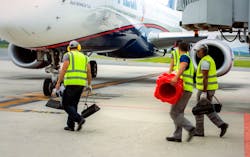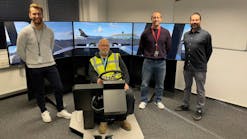Ground Handling’s Virtual Classroom
Online learning as a ground handling training delivery mode has evolved significantly as a consequence of the global COVID-19 pandemic. There are now different uses of online learning compared to what was in use before the pandemic.
According to Ricardo Miguel, president of Brazil’s ABESATA, one of the biggest challenges resulting from the pandemic was to ensure compliance with the annual training programs, with priority given to regulatory instruction aspects.
“It was necessary to assess the risk of providing online training at 100 percent. Risk assessing, considering several variables such as internet access, computer/cell phone/tablet accessibility, use of the online teaching platform, technological learning and other aspects, we concluded that we would have to rethink the training process in order for it to become effective with both synchronous and asynchronous online learning,” he says.
Becoming Standard
Henry “Duke” LeDuc, regional operations director at UAS observes that, in general, prior to COVID-19, online learning was not very prevalent.
“We primarily utilized in-person meeting for training. We have used training more effectively with the online learning. We have used the typical platforms for virtual communication, i.e., Teams, Zoom, etc. The trainings are recorded, and a live question-and-answer is available. We have also adopted video training modules and a dedicated training syllabus,” he says.
During the pandemic, in several ABESATA member companies the development of online learning was exponential, according to Miguel.
“This was due to the educational quality of the training contents and to the educational strategies adopted by the instructors in the different stages of synchronous training and in the preparation of asynchronous training to verify learning,” he says. “Before the pandemic, online training had mainly a complementary role, in particular for information transfer. Today, the methodology is used in around 70 percent of internal training, including training due to technological evolution and development of our human capital in a digital platform environment.”
Benefits of Online Learning
According to LeDuc, online learning has made it possible to provide more training accessibility to people on various shifts.
“It has also made it more cost-effective and allows the trainees to review a second or third time if needed. This helps the trainee progress at their own pace,” he says.
Miguel observes that as per capita income in Latin America is lower than in Europe and North America, the ground service providers’ charges are also lower.
“As a result, investment in training for air transport tends to follow this pattern. With the arrival of the pandemic and the intense use of the online platform, everything was leveled and the learning process in Latin America gained as a result,” he says.
The main challenge of online training is to guarantee the participation and assimilation of learning in a virtual environment, according to Miguel.
“In fact, trainees can easily lose interest and even without the proper controls, they may not even participate. As a great benefit, it is worth pointing out the reduction of costs associated with renting rooms and multimedia tools such as audio/visual aids as a component of the investment in training,” he says.
Miguel observes that, in general, in Central and South America during the pandemic there were mostly online classes with a PowerPoint presentation and the instructor broadcasting the slides or animated presentations without a facilitator involved in the stages of verification and application of knowledge.
“However, it is noteworthy that the pandemic constraints that marked this situation led this region of the world to invest in practical training through simulators, with situations very close to reality, which allowed, for example, to train equipment operators in a virtual environment,” he says. “The major beneficiaries of online learning are the trainees, as they now have advanced techniques, with well-developed resources and learning tools.”
Training Topics
UAS has taken each of the most critical tasks and ensured the processes have been documented in a standard format and that there is an accompanying video, affirms LeDuc.
“This library of processes is available to the team via a searchable intranet,” he says.
According to Miguel, most aircraft ground handling training topics can be covered in online learning.
“In the vast majority of GSPs in Brazil, for example, the courses which technically train employees and are mandatory for the performance of functions are almost all taught in a synchronous online environment, with the presence of an instructor. These include courses in integration, operations in adverse weather conditions, airside safety, security and dangerous goods,” he says. “In addition, the training and qualification courses for functions such as passenger service agent, ramp assistant and ramp operations supervisor, also have a face-to-face practical component and assessment through on-job learning and assessment on top of the online synchronous component.”
Many of the courses which specialize an employee in a certain area, or which complement technical training, are taught to be delivered online, affirms Miguel.
“Internally, some courses have been taught completely online, namely safety management system (SMS), ISAGO for aircraft assistance service providers and training for e-instructors on eLearning,” he says. “The courses with a behavioral component that aim to raise awareness and promote safety, are now completely taught in an online environment, either synchronous or asynchronous. These include human factors and crew resource management (CRM), leadership and safety management.”
Challenges of an Online Learning Program
In order to qualify for an aircraft ground handling function, the physical/in-person environment is conducive to training, since knowledge of the space where the activity will be developed and the tools to be used in carrying out the tasks is of valuable importance, observes Miguel.
“Among the major challenges of an online learning program, we identified the restructuring of course programs, including the workload and the teaching methodology,” he says. “In a virtual environment, interaction and motivation techniques to foster group dynamics are completely different from those used in face-to-face learning, and the training of instructors requires that they be prepared for changes in behavior in the face of the virtual teaching model. Finally, there was also a restructuring of the assessment of learning.”
LeDuc believes that the limited personal interaction is indeed the biggest barrier in the implementation in an online learning program.
“The majority of the communication is non-verbal, and this can be missed in a virtual setting. We ask that the camera be on during training sessions and that the team members give their full attention in the meeting,” he says. “Additionally, one has much greater engagement from the team when there is buy-in from the trainees. The organization must believe in the need for the training and communicate the benefits of training to the individual team members.”
In order to overcome the difficulties of implementing the transformation of face-to-face teaching into virtual teaching, there has to be a good management of change, according to Miguel.
“Change management should focus on the main vectors that the change entails, on the identification and scope of change, on the evaluation of the impact of the changes in the training process, on carrying out a risk analysis to identify the susceptibilities that may compromise the effectiveness of teaching, and on the implementation of an action plan and communication as a catalyst for this entire process,” he says. “Based on these assumptions, the implementation of online education becomes easier and more effective. Consequently, ground handling organizations should bet on the training of instructors and the choice of a training support platform that is adequate to the needs and dynamization of training actions.
“In order to consolidate training in a virtual environment, it is necessary to monitor and periodically evaluate the training performance in order to make the necessary adjustments and thus overcome the great challenges that training in a virtual environment provides,” concludes Miguel.







